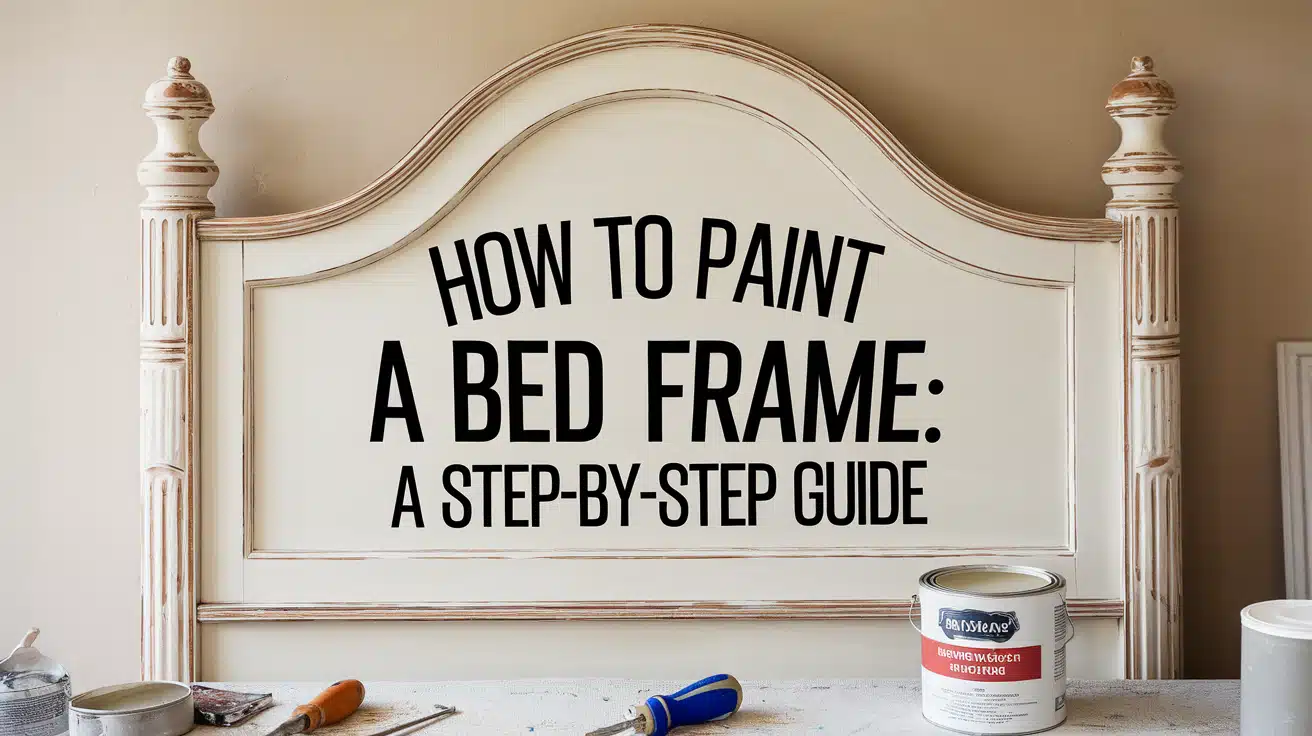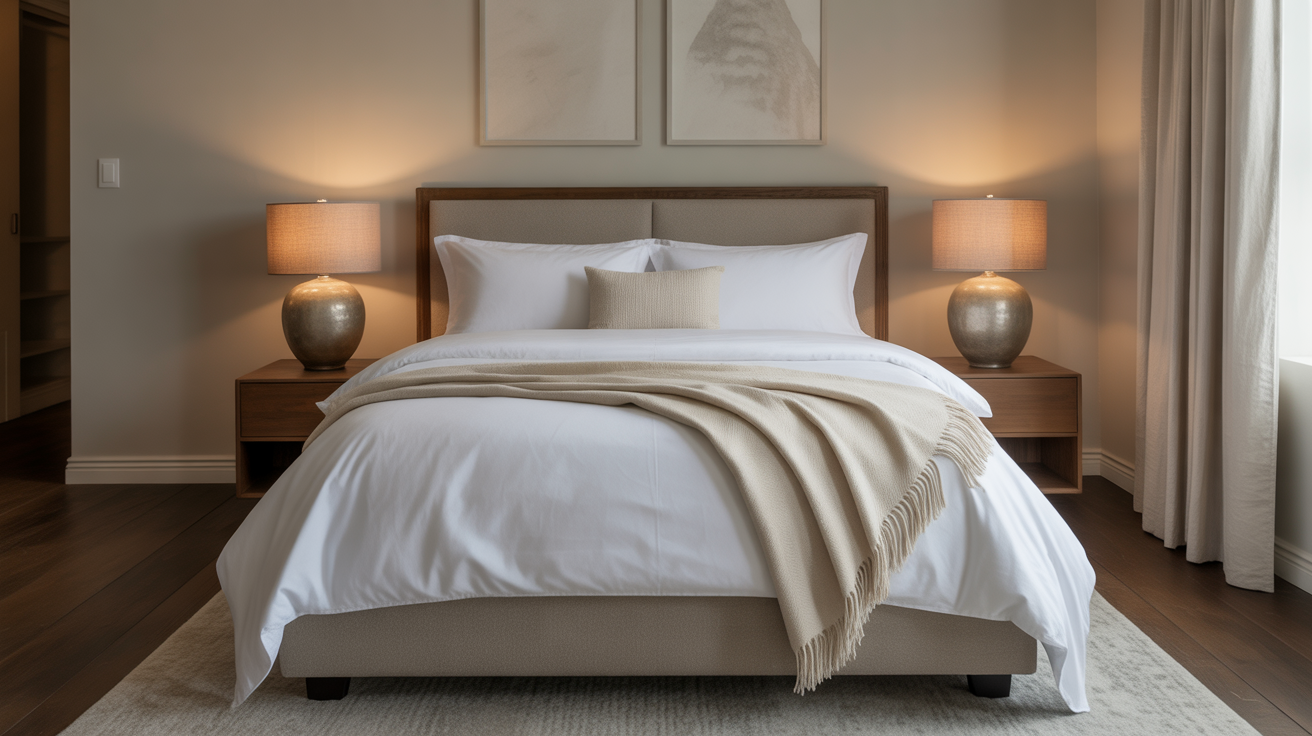How to Paint a Bed Frame: A Step-by-Step Guide
A fresh coat of paint on your bed frame brings new life to your bedroom. But many people hesitate to start this project, worried about messing up their furniture with drips, runs, or uneven coverage.
Good news: painting your bed frame doesn’t require expert skills. With the right steps and tools, you can achieve results that look like professional work.
In this guide, you’ll learn which paints work best for different bed frames, how to prep your surface properly, and the exact steps to get a smooth finish.
Plus, you’ll find simple tricks to maintain your painted bed frame’s beauty for years. Let’s turn your old bed frame into a stunning bedroom centerpiece.
Understanding Bed Frame Materials: What You Need to Know Before You Start
Your bed frame’s material shapes every step of your painting project. Each type needs specific preparation and techniques. Let’s look at two main options and their special requirements.
Wooden Bed Frames
Wood brings natural beauty to any bedroom. These frames offer a timeless appeal that fits many home styles. Here’s what makes wooden frames stand out:
The warm feel of wood creates a cozy bedroom setting. Its natural grain patterns add character that shows through even after painting. Each wooden frame tells its own story through its unique marks and textures.
Benefits of wooden frames:
- You can sand them smooth with basic tools
- Paint sticks well to properly prepared wood
- You can change colors many times over the years
- Small fixes are often simple to handle
Keep in mind these points:
- You’ll need time for proper sanding
- Old paint or stain must come off first
- Wood might need filling to fix small holes
- The surface soaks up more paint than other materials
Metal Bed Frames
Metal frames bring clean lines and strength to your bedroom setup. These frames stand firm and often last for years. Their smooth surface takes well to new paint with the right prep work.
Key features of metal frames:
- Strong build that stays stable
- Smooth surface that paint can grip
- Less prep work is needed before painting
- Long-lasting results when done right
Watch out for these aspects:
- It would be best if you had paint made for metal
- Rust spots need special treatment
- Even coverage takes careful work
- Some paints might chip if not properly applied
Planning Your Project: Setting Yourself Up for Success
Smart planning before picking up a paintbrush saves you time and money. A clear plan helps you finish your project without costly mistakes or do-overs.
DIY or Buy New? Let’s Weigh the Options
| Comparison Factor | DIY Paint Job | New Bed Frame |
|---|---|---|
| Average Cost | $50-$100 | $200-$1000+ |
| Time Investment | 1-2 days | None |
| Customization | Full control | Limited options |
| Skill Level | Basic | None needed |
Choosing Your Design and Color Scheme
Current bedroom styles show two main paths. Some folks pick soft, calm colors, while others go for bold statements. Your choice sets your room’s mood.
| Finish Type | Best For | Durability | Cleaning |
|---|---|---|---|
| Matte | Hiding flaws | Medium | Harder |
| Satin | Daily use | High | Easy |
| Gloss | Bold looks | Very high | Easiest |
Paint Selection Guide
| Surface | Recommended Paint | Notes |
|---|---|---|
| Wood | Latex paint | Good coverage |
| Metal | Metal-specific | Better grip |
| Both | Quality spray paint | Even finish |
Essential Tools Checklist
| Basic Tools | Safety Items | Extra Supplies |
|---|---|---|
| Brushes | Face mask | Drop cloths |
| Rollers | Gloves | Painter’s tape |
| Sandpaper | Safety glasses | Clean rags |
| Primer | Work clothes | Stir sticks |
Step-by-Step Guide: How to Paint Your Bed Frame Like a Pro
Step 1: Initial Preparation
The first steps make a big difference in your final results. Start by checking your bed frame for screw holes. Mix your wood filler with a bit of water until it feels like clay – this makes it easier to work with. Press the filler into each hole with care.
Take a flat scraper and smooth the filled spots until they sit level with the wood surface. Let each filled area dry completely.
Step 2: Sanding
A smooth surface forms the base for good paint coverage. Start with 150-grit sandpaper on the entire frame. Pay extra attention to any spots that feel rough under your fingers.
Once you’ve reviewed everything, switch to 220-grit sandpaper for a final pass. You won’t need much sanding for bare wood – just enough to ensure an even surface.
Step 3: Polyurethane Application
The headboard and footboard often look best with their natural wood showing through. Apply a coat of satin polyurethane to these parts. Let it dry fully, then add a second coat.
This step not only brings out the wood’s natural patterns but also makes it simple to wipe off any paint that might get on these areas later.
Step 4: Painting
Pick your paint color with care—an off-white shade with warm hints works well in most rooms. To save time, use paint with built-in primer. Apply your first coat evenly across all surfaces. You’ll likely need three coats for full coverage. Let each layer dry before adding the next one.
Step 5: Details and Touch-ups
Take a small brush for precise work around the areas with polyurethane. Work slowly near these spots to keep lines clean. Keep a damp cloth ready to wipe away any paint that gets where it shouldn’t. Pay special attention to corners and hard-to-reach spots.
Step 6: Finishing Touches
Give each coat time to dry – rushing this step can ruin your hard work. Check the paint can for specific drying times. Look over your work between coats to spot any areas that need extra attention. Good lighting helps you catch any missed spots.
Step 7: Final Look
Your painted bed frame should now match your room’s style perfectly. The satin finish offers the right amount of shine while standing up to daily use.
This update can make your whole room feel fresh and put together. With proper care, your painted bed frame will keep its good looks for years.
Video Tutorial
Watch the full YouTube video on how to paint a bed frame.
Maintenance and Care: Keeping Your Painted Bed Frame Looking Fresh

Your painted bed frame needs proper care to stay beautiful. Simple daily habits greatly affect how long your paint job lasts.
Cleaning Your Painted Bed Frame
Start with basic cleaning methods that won’t harm your paint. A soft microfiber cloth works best for daily dusting. When you need deeper cleaning, mix mild dish soap with warm water.
Always test your cleaning solution on a hidden spot first. Pat the surface gently rather than scrubbing hard. Harsh chemicals and rough sponges can damage your paint job, so stick to gentle products made for painted furniture.
Handling Wear and Tear
Small chips and marks will appear over time – just part of using your bed. Save your paint color code and keep a small amount for touch-ups. When you spot a chip, sand the area lightly before applying new paint.
A small artist’s brush gives you good control for precise fixes. Prevention matters, too. Felt pads between your frame and the wall stop scrapes. Careful movements during sheet changes protect your paint job. Teaching children to treat the bed gently helps avoid damage.
Longevity Tips
With consistent care, your paint can look fresh for years. Make cleaning part of your weekly routine. Catching problems early means simpler fixes. A quick monthly check helps you spot wear before it gets worse. Clean any spills right away—even water can leave marks if left too long.
Protection from Sun and Moisture
Sunlight and water create the biggest risks for your paint job. Window coverings block harmful rays that fade paint, and good airflow stops moisture from building up near your bed.
Watch out for heating vents nearby – they can cause paint to crack over time. Keep your room at a steady temperature and humidity level.
Conclusion
A painted bed frame does more than change the look of your furniture—it changes how your whole bedroom feels. Small steps like proper prep work, careful paint choice, and patient application add to results you’ll love seeing daily.
Remember that success comes from taking your time with each step. Good sanding creates a smooth base. The right paint helps your color last longer. Proper drying time between coats builds a strong finish.
Your care after painting matters, too. Simple cleaning, quick fixes for small marks, and protection from sun and moisture keep your bed frame looking fresh.
With these steps, you’ve turned a basic bedroom piece into something special that fits your style perfectly. Your painted bed frame is ready to bring you joy for years ahead.







